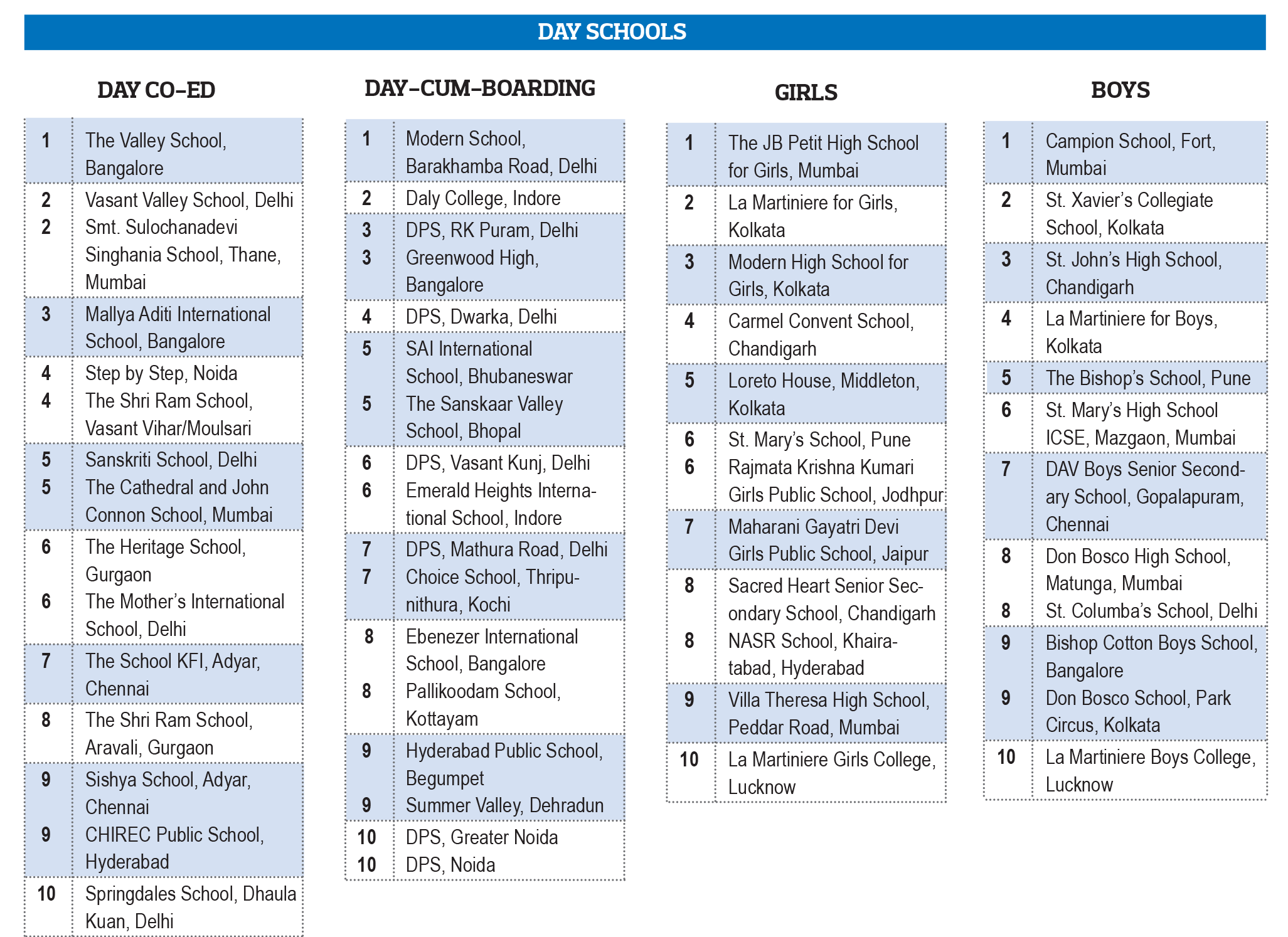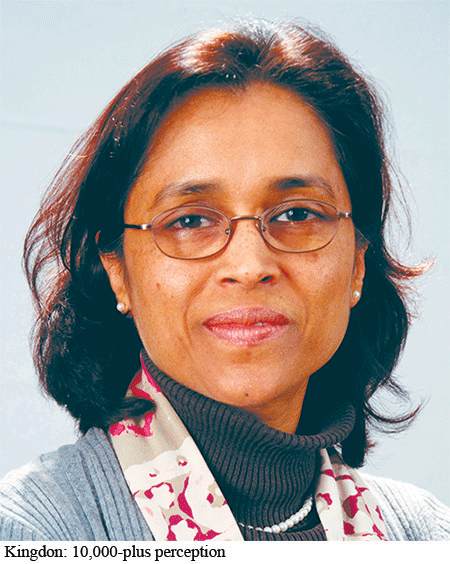Over the past four months 140 C fore field personnel interviewed 10,301 parents, principals, teachers and senior school students in 28 cities countrywide, and persuaded them to rate schools in their region on a ten-point scale across 14 parameters of education excellence - Dilip Thakore & Summiya Yasmeen


Way back in 2007, EducationWorld, launched on the eve of the new millennium with the avowed mission to “build the pressure of public opinion to make education the #1 item on the national agenda”, commissioned the first-ever survey to rate and rank India’s most respected and admired schools. The purpose behind the nationwide market research survey was to alert promoters, principals and teachers of primary-secondary schools who tend to live in secluded ivory towers, that their education delivery performance will be evaluated, measured and compared with schools countrywide on a broad range of parameters.
Since then over the years, the annual EducationWorld India School Rankings have been fine-tuned to emerge as the most reason and logic-driven schools ranking league tables in India, and perhaps globally. In 2013 persuaded by the logic that apples shouldn’t be compared with oranges, the earlier process of evaluating day, boarding and international schools in these three broad categories was abandoned to rate and rank them according to ten more narrowly defined categories. Since then, day schools were sub-divided into day boys, girls, co-ed and day-cum-boarding categories; boarding schools into boys, girls and co-ed, and international schools into day, day-cum-boarding and wholly residential categories.
Some sceptics and cynics scoff that the fine subdivisions within each category enable us to recognise and felicitate a larger number of institutions. That’s a charge we freely admit. This is why over the past several years, C fore field personnel have started conducting field surveys to rate and rank the best government and private budget schools countrywide as well. The Top 10 schools in each category are invited to be felicitated at the EW India School Rankings 2016 Awards Nite at the Leela Hotel in Gurgaon (Delhi NCR) on September 23-24. As in the past seven years, this will be the largest annual conclave of school promoters, principals and educators countrywide. This gala two-day event will also be globally livestreamed on www.educationworld.in.
Against this contextual backdrop, in this long-awaited special issue of EW, we present the EducationWorld India School Rankings 2016 league tables of the country’s Top 1,000 schools in 13 different categories not only nationally, but also in the states and major cities. It’s pertinent to bear in mind that most of India’s states are as populous as most European and African countries. Therefore a Top 10 rank in a state is no mean achievement. Moreover, in response to sceptics who criticised the EW league tables for being perceptions based — for which we make no apology because the aggregated perceptions of 10,000-plus individuals with subject knowledge are more credible than unverified ‘facts’ volunteered by schools — this year, we have appended the actual scores of schools in the CISCE and CBSE school-leaving board exams.
Be that as it may, in the spirit of continuous improvement this year, 140 C fore field representatives persuaded a record 10,301 sample respondents — educationists, institutional promoters, principals, SEC (socio-economic category) ‘A’ parents, teachers and senior school students — over a period of four months to rate over 1,100 schools in 28 cities countrywide.
The parameters of assessment are teacher welfare and development, competence and commitment of faculty, academic reputation, co-curricular education, sports education, and infrastructure provision plus eight others. Scores awarded to each school by sample respondents in its region (north: 3,939, south: 2,792, east: 1,532 and west: 2,038) under each parameter were aggregated to arrive at totals according to which schools are ranked. Schools are rated and ranked only by respondents in their geographical regions or zones on the assumption that they may not be familiar with institutions in regions other than their own. Low-profile schools rated by less than 25 respondents are not included in the league tables.
In sharp contrast to the many pains and substantial expense we incur to present our annual league tables assessing the country’s Top 1,000 schools, Anil Sharma, a former marketing executive of EducationWorld and currently chief executive of an online website named and styled Education Today (a knock-off of our own www.educationworld.in), has concocted a home-brewed version of annual school rankings which is being passed off to schools and corporates. We advise educators, parents and our customers to exercise judgement and not to confuse the annual EducationWorld India School Rankings with fraudulent imitations.
 “The annual EW India School Rankings serve a useful socio-economic purpose because they foster healthy competition among schools and prompt them to innovate to improve real learning outcomes. It’s notable that the top-ranked schools in each category are institutions which have introduced new pedagogies to create active learners within classrooms. Previously popular ‘convent’ schools which still rely on chalk-n-talk pedagogies to educate passive learners are consistently losing rank,” says Premchand Palety, the promoter-CEO of C fore. An engineering and business management graduate of Panjab University and the Fore School of Management, Delhi, Palety served with ORG — India’s pioneer market research company — for over a decade prior to promoting C fore in 2000. Among the company’s major clients: Hindustan Times, Nestle India, Live Mint and “several political parties” which commission the conduct of voter opinion polls.
“The annual EW India School Rankings serve a useful socio-economic purpose because they foster healthy competition among schools and prompt them to innovate to improve real learning outcomes. It’s notable that the top-ranked schools in each category are institutions which have introduced new pedagogies to create active learners within classrooms. Previously popular ‘convent’ schools which still rely on chalk-n-talk pedagogies to educate passive learners are consistently losing rank,” says Premchand Palety, the promoter-CEO of C fore. An engineering and business management graduate of Panjab University and the Fore School of Management, Delhi, Palety served with ORG — India’s pioneer market research company — for over a decade prior to promoting C fore in 2000. Among the company’s major clients: Hindustan Times, Nestle India, Live Mint and “several political parties” which commission the conduct of voter opinion polls.
The value of the annual EducationWorld India School Rankings league tables to education improvement and reform is endorsed by Dr. Geeta Kingdon, director of the City Montessori School, Lucknow’s top-ranked co-ed day school and more pertinently, chair of education economics and international development at the Institute of Education, University of London.
 “Perhaps the only drawback of these rankings is that they are essentially perceptual. But this issue has been addressed by the simultaneous presentation of hard factual data of performance in school-leaving exams. Perceptual rankings under the other parameters which are hard — if not impossible — to measure objectively are persuasive, particularly since they are the perceptions of over 10,000 knowledgeable individuals countrywide,” says Kingdon.
“Perhaps the only drawback of these rankings is that they are essentially perceptual. But this issue has been addressed by the simultaneous presentation of hard factual data of performance in school-leaving exams. Perceptual rankings under the other parameters which are hard — if not impossible — to measure objectively are persuasive, particularly since they are the perceptions of over 10,000 knowledgeable individuals countrywide,” says Kingdon.
Against this backdrop of a comprehensive national survey conducted over a period of four months, we present this year’s league tables evaluating India’s Top 1,000 schools in 13 differentiated categories. These institutions, also ranked separately in their states and cities, are leading India’s charge into 21st-century primary-secondary teaching-learning in an official and societal environment which is indifferent, if not downright hostile, to education excellence.